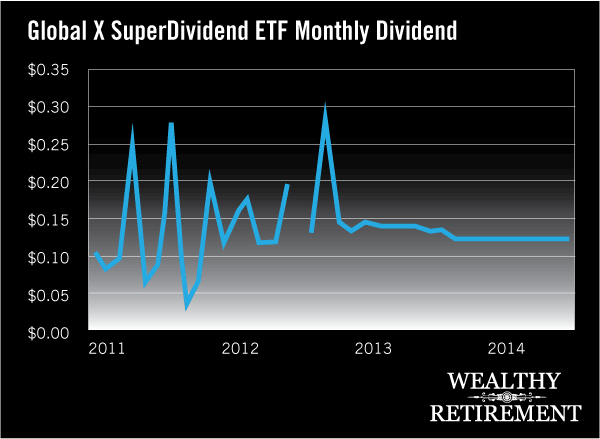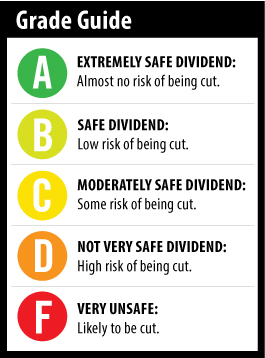 I categorize dividend investors into two camps: those who will accept fluctuations in the dividend in order to try to achieve higher yields, and those who want consistency from their dividends.
I categorize dividend investors into two camps: those who will accept fluctuations in the dividend in order to try to achieve higher yields, and those who want consistency from their dividends.
Generally speaking, I’m in the latter camp. I want to know that the stocks I recommend to readers will pay a consistent (and usually rising) dividend. I don’t want to be concerned that the company will reduce its payout.
That’s the basis for the Safety Net column – to analyze how likely a company is to continue to pay its dividend. For investors relying on dividends for income, it’s an important issue.
[ad#Google Adsense 336×280-IA]I usually don’t take a look at ETFs, but Frank’s suggestion that I analyze Global X SuperDividend ETF (NYSE: SDIV) intrigued me because it pays a 5.8% dividend yield.
The ETF tracks the Solactive Global SuperDividend Index.
The index is composed of the top 100 highest-yielding stocks in the world.
Stocks from the United States comprise 26% of the index.
Australia is the next-largest country in the index at 19%.
It’s followed by Canada at 9.4% and the United Kingdom at 6.5%.
Two of the index’s top three holdings are Windstream Holdings (Nasdaq: WIN) and Frontier Communications (Nasdaq: FTR). I analyzed Windstream just last week. I had to give the stock an “F” for dividend safety because the company already announced a reduction.
Frontier cut its dividend nearly in half two years ago. Since then, its cash flow has been sufficient to pay the dividend, so I don’t have reason to suspect another decrease is imminent.
With 100 stocks and three-quarters of them foreign, it would take me a long time to go through each one to try to determine the likelihood that the Global X SuperDividend ETF will or won’t cut its dividend.
Instead, let’s look at the ETF’s history.
The ETF pays a monthly dividend. This year, the dividend has been $0.121 each month. That’s down 11% from last year’s average monthly distribution of $0.136 and the prior year’s $0.131. In fact, you can see from the chart below that the monthly dividend has been all over the place since the ETF was launched in 2011.
 A company’s dividend-paying track record is one of the key variables that I look at when determining the safety of a dividend. A company that has shown the willingness to reduce the dividend in the past likely will do so again.
A company’s dividend-paying track record is one of the key variables that I look at when determining the safety of a dividend. A company that has shown the willingness to reduce the dividend in the past likely will do so again.
On the flip side, a management team that has refused to lower the dividend over the years shows investors that the consistency of the dividend is very important and that it understands the dividend is an essential reason why some investors own the company.
 A company like AT&T (NYSE: T), which has raised its dividend every year for 30 years, has clearly displayed that its dividend is a priority.
A company like AT&T (NYSE: T), which has raised its dividend every year for 30 years, has clearly displayed that its dividend is a priority.
There’s nothing wrong with owning a globally diversified, high-yielding ETF.
In fact, I like the concept. Just don’t expect your payout to be the same each month or each year.
There are elements, such as currency fluctuation and the dividend policy of the companies that make up the index, that are beyond the ETF management’s control.
As a result, there’s a very good chance that, at some point, the dividend will head lower than what investors will have received the prior month.
Dividend Safety Rating: D
— Marc Lichtenfeld
[ad#IPM-article]
Source: Wealthy Retirement
